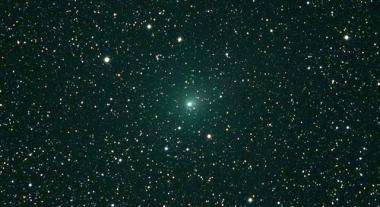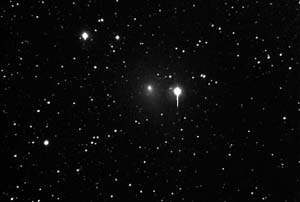The comet cometh: Hartley 2 visible in night sky

(PhysOrg.com) -- Backyard stargazers with a telescope or binoculars and a clear night's sky can now inspect the comet that in a little over two weeks will become only the fifth in history to be imaged close up. Comet Hartley 2 will come within 17.7 million kilometers (11 million miles) of Earth this Wed., Oct. 20 at noon PDT (3 p.m. EDT). NASA's EPOXI mission will come within 700 kilometers (435 miles) of Hartley 2 on Nov. 4.
"On October 20, the comet will be the closest it has ever been since it was discovered in 1986 by Australian astronomer Malcolm Hartley," said Don Yeomans, head of NASA's Near-Earth Object Office at the Jet Propulsion Laboratory in Pasadena, Calif. and a member of the EPOXI science team. "It's unusual for a comet to approach this close. It is nice of Mother Nature to give us a preview before we see Hartley 2 in all its cometary glory with some great close-up images less than two weeks later."
Comet Hartley 2, also known as 103P/Hartley 2, is a relatively small, but very active periodic comet that orbits the sun once every 6.5 years. From dark, pristine skies in the Northern Hemisphere, the comet should be visible with binoculars as a fuzzy object in the constellation Auriga, passing south of the bright star Capella. Viewing of Hartley 2 from high ambient light locations including urban areas may be more difficult.
In the early morning hours of Oct. 20, the optimal dark sky window for mid-latitude northern observers is under two hours in length. This dark interval will occur between the time when the nearly-full moon sets at about 4:50 a.m. (local time) and when the morning twilight begins at about 6:35 a.m.
By October 22, the comet will have passed through the constellation Auriga. It will continue its journey across the night sky in the direction of the constellation Gemini.

EPOXI is an extended mission that utilizes the already "in-flight" Deep Impact spacecraft to explore distinct celestial targets of opportunity. The name EPOXI itself is a combination of the names for the two extended mission components: the extrasolar planet observations, called Extrasolar Planet Observations and Characterization (EPOCh), and the flyby of comet Hartley 2, called the Deep Impact Extended Investigation (DIXI). The spacecraft will continue to be referred to as "Deep Impact."
More information: Images and videos of comet Hartley 2 from both amateur observers and major observatories are online at: aop.astro.umd.edu/gallery/hartley.shtml .
Provided by JPL/NASA





















